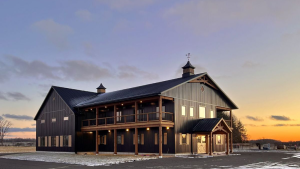Kingston’s $115-million Ravensview water treatment plant upgrade is well over half done as project managers anticipate looking forward to meeting their original September 2009 completion date.
$115 million project to improve discharge quality into Lake Ontario
Kingston’s $115-million Ravensview water treatment plant upgrade is well over half done as project managers anticipate looking forward to meeting their original September 2009 completion date.
“Overall, the project is about 55 per cent completed. In the coming months, most of the new equipment will be tested, started up and put into operation,” said Allen K. Lucas, an engineer for Utilities Kingston.
The massive project, which is being managed by J.L. Richards and Associates and built by Pomerleau Ontario, will be able to handle 30 per cent more waste than the current facility, thereby revolutionizing the way waste is treated in Kingston and vastly improving the quality of water discharged into Lake Ontario.
Last year, managers feared the retrofit’s completion date would be delayed after two labour actions created a five-week work backlog.
Labourers who are members of the Labourers International Union of North America and crane operators who are members of the International Union of Operating Engineers walked off the site for a total of three weeks.
J.L. Richards and Associates project manager Dan Lalande and Pomerleau Ontario project director Normand Fortin said in all their years in the business, they had never had to make up so much time.
But they did.
Between 50 and 60 workers were on the site all winter working on installing electrical, piping and mechanical equipment and doing internal finishing work.
“As far as major milestones go, the one we are concentrating on right now is the secondary treatment process,” said Jim Keech, president and CEO of Utilities Kingston.
Concrete placement is now being done to finish off the biological aerated filters, which are being installed for secondary treatment. They will ensure the water discharged into Lake Ontario after treatment is cleaner than the city’s current primary treatment sewage system.
The biological aerated filter system is being touted as the largest of its kind in Canada.
“The BAF cells are nearing completion and will be tested in a couple of months in preparation for loading the media and start-up by September this year,” said Lucas. He added that the new pumping station in the biological aerated filter facility is complete and the pumps are installed.
The project’s new 44 kV electrical service is also set to be energized soon. It will feed through new transformers.
New back-up power generators have been installed and will be up and running in the coming months, as will the plant’s new co-generation unit.
“These will be operational in the next month or two, which will enable proceeding with the boiler replacement and upgrades to the operations building,” Lucas said. Screen and grit removal units have been operational since last fall.
Meanwhile, work on two of the system’s primary clarifiers is also complete. Lucas said the weather will have to improve before work can continue on the remaining five clarifiers.
The plant’s new dewatering building is being fitted out electrically and mechanically and should be complete by fall. Its new centrifuges and biosolids movement equipment is in place and will be connected so it will be ready for start-up, Lucas said.
The Ravensview upgrade isn’t the only big water-treatment infrastructure project underway in the city.
A 9,000-cubic-litre water storage facility is slated for construction in Kingston’s west end in 2009, while an upgrade to a western water treatment plant’s hydraulic capacity will begin in 2010.
The water treatment plant will almost double in hydraulic capacity from 45,000 cubic metres per day to 80,000 cubic metres per day.
J.L. Richards has been hired to do environmental assessments for both projects.
“Population growth and business growth have made this necessary,” said Keech. “Also, we want to make sure there’s ample supply for fighting fires as well.”
Construction will also start this year downtown on the replacement of a sanitary storm sewage pipe with two pipes, which will separate rainwater from sewage so that the cleaner water is taken straight to Lake Ontario while dirtier water is carried off treatment.










Recent Comments
comments for this post are closed